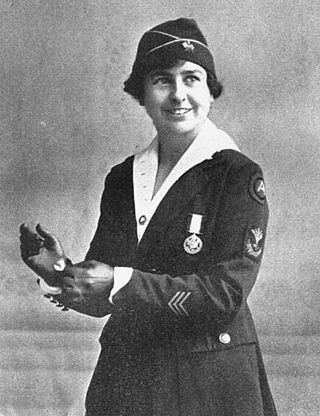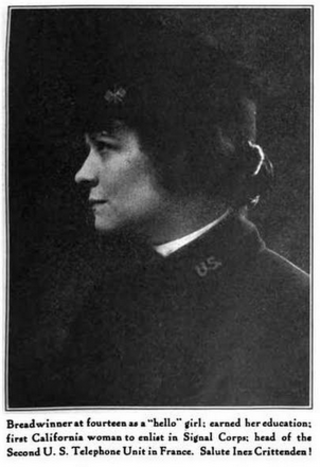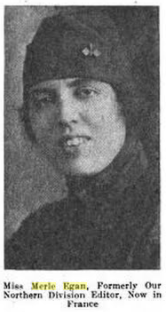Related Research Articles
The Pacific Bell Telephone Company (Pac Bell) is a telephone company that provides telephone service in California. The company is owned by AT&T through AT&T Teleholdings, and, though separate, is now marketed as “AT&T”. The company has been known by a number of names during which its service area has changed. The formal name of the company from the 1910s through the 1984 Bell System divestiture was The Pacific Telephone and Telegraph Company. The “Pacific Bell” was phased out of public use in 2002, although it remains the legal name of AT&T's local operating company in California and is still the holder of record for the infrastructure of cables and fiber through much of California.

The Mountain View Cemetery is a 226-acre (91 ha) rural cemetery in Oakland, California, United States. It was established in 1863 by a group of East Bay pioneers under the California Rural Cemetery Act of 1859. The association they formed still operates the cemetery today. Mountain View was designed by Frederick Law Olmsted, the landscape architect who also designed New York City's Central Park and much of UC Berkeley and Stanford University.

Women in World War I were mobilized in unprecedented numbers on all sides. The vast majority of these women were drafted into the civilian work force to replace conscripted men or to work in greatly expanded munitions factories. Thousands served in the military in support roles, and in some countries many saw combat as well.

The United States declared war on Germany on April 6, 1917, nearly three years after World War I started. A ceasefire and armistice were declared on November 11, 1918. Before entering the war, the U.S. had remained neutral, though it had been an important supplier to the United Kingdom, France, and the other powers of the Allies of World War I.

Hello Girls was the colloquial name for American female switchboard operators in World War I, formally known as the Signal Corps Female Telephone Operators Unit. During World War I, these switchboard operators were sworn into the U.S. Army Signal Corps. Until 1977 they were officially categorized as civilian "contract employees" of the US Army. This corps was formed in 1917 from a call by General John J. Pershing to improve the worsening state of communications on the Western front. Applicants had to be bilingual in English and French to ensure that orders would be heard by anyone. Over 7,000 women applied, but only 450 women were accepted. Many of these women were former switchboard operators or employees at telecommunications companies. They completed their Signal Corps training at Camp Franklin, now a part of Fort George G. Meade in Maryland.
This article is about the role played by women in the military in the Americas, particularly in the United States and Canada from the First World War to modern times.

Caro Roma was the stage name of Carrie Northey, an American singer and composer known for Tin Pan Alley era songs.

Although they often faced obstacles and policy limitations, beginning in the early 1900s a few women were able to participate in the pioneering development of radio communication.
This is a timeline of women in warfare in the United States from 1900 until 1949.

World War I marked the first war in which American women were allowed to enlist in the armed forces. While thousands of women did join branches of the army in an official capacity, receiving veterans status and benefits after the war's close, the majority of female involvement was done through voluntary organizations of the war effort or through becoming a nurse for the military. Additionally, women made an impact on the war indirectly by filling the workforce, becoming employed in the jobs left behind by male soldiers.

Mabel Isabel Riegelman was a popular American operatic soprano.

Grace D. Banker was a telephone operator who served during World War I (1917–1918) as chief operator of mobile for the American Expeditionary Forces (AEF) in the U.S. Army Signal Corps. She led thirty-three women telephone operators known popularly as Hello Girls. They were assigned in New York to travel to France to operate telephone switch boards at the war front in Paris, and at Chaumont, Haute-Marne. They also operated the telephone switch boards at First Army headquarters at Ligny-en-Barrois, about 5 miles (8.0 km) to the south of Saint-Mihiel, and later during the Meuse-Argonne Offensive. After her return to civilian life, Banker and her team members were treated as citizen volunteers and initially not given recognition as members of the military. In 1919, Banker was honoured with the Distinguished Service Medal for her services with the First Army headquarters during the St. Mihiel and Meuse-Argonne Offensives, with a commendation.

Inez Ann Murphy Crittenden was a leader of the "Hello Girls", the U. S. Telephone Corps in France during World War I.

USS Santa Olivia (SP-3125) was a cargo ship and later troop transport that served with the United States Navy during and after World War I. The ship later went into merchant service as a freighter, and during World War II took part in a number of transatlantic convoys.

USS Radnor (ID-3023) was a cargo ship and later troop transport that served with the United States Navy in 1918–19, during and shortly after World War I. The ship later went into merchant service, and in 1948 under Chinese ownership reportedly became the first all-Chinese ship to visit South America. Radnor was originally ordered as SS War Indian by a private company, but with U.S. entry into World War I in April 1917, she was requisitioned by the U.S. Navy for use as a cargo ship. Commissioned as USS Radnor (ID-3023) in May 1918, the ship spent the remainder of the war transporting cargoes for the Navy. After the war, USS Radnor was converted into a troop transport and used to repatriate U.S. troops home from France.

Merle Egan Anderson was a member of the United States Army Signal Corps' Female Telephone Operators Unit during World War I. She is one of the first 447 female veterans of the U.S. Army. She is credited for persisting in the effort to gain the Operators Unit veterans' status, which was eventually signed into law by President Jimmy Carter in 1977.
Enid Bauer Foster was an American artist, sculptor, poet, playwright and performing artist best known in later life for her oil paintings and especially her monotype pen drawings, a medium she developed. She was at the center of Sausalito's 1950s–1960s art colony.

Hettie Belle Ege was an American professor of mathematics. From 1914 to 1916, she was the acting president of Mills College.

Beulah Ream Allen was an American nurse, physician, and civilian physician during World War II. After graduating with a nursing degree in 1922, she worked as a supervising nurse and headed the educational department for the LDS Hospital in Salt Lake City. She worked as a hospital inspector for the state of Utah until 1928, when she moved to San Francisco to attend medical school. While earning her degree at the University of California, San Francisco, she worked as a nurse in the Bay Area. Upon her graduation in 1932, she moved to the Philippines, where she opened a medical practice.

Minora Ellis Kibbe was a social reformer and suffragist from California. She ran for a seat on the San Francisco area school board in 1908, and for California's 36th State Assembly district in 1918.
References
- 1 2 McKinney, Joan (1979-08-28). "After 60 years, 'Hello Girl' gets Army farewell salute". Oakland Tribune. p. 11. Retrieved 2025-01-05.
- ↑ "Louise le Breton gives firsthand account of her time as a telephone operator in the Signal Corps". San Francisco Chronicle. 25 May 1919. p. 12.
- ↑ "Two little girls have a long journey". Morning Register. 1912-01-18. p. 5. Retrieved 2025-01-05.
- 1 2 3 Klein, Karen (1979-08-28). "We were the Army's first women". The Berkeley Gazette. pp. 1, . Retrieved 2025-01-05.
- 1 2 3 "Mother sends two daughters, has no sons". Oakland Tribune. 1918-01-29. p. 4. Retrieved 2025-01-05.
- ↑ "Local French consulate busied with enlistments". San Francisco Bulletin. 1914-08-03. p. 4. Retrieved 2025-01-05.
- 1 2 Hogan, Mary Ann (1982-12-27). "Military salutes women". Oakland Tribune. pp. 19, . Retrieved 2025-01-05.
- ↑ "S.F. girl who aided Pershing reaches home". San Francisco Chronicle; San Francisco, California. 1919-05-25. Retrieved 2024-11-20.
- 1 2 "Affidavit of Louise le Breton Maxwell - 1977 | GG Archives".
- ↑ McKinney, Joan (1979-08-28). "After 60 years, 'Hello Girl' gets Army farewell salute". Oakland Tribune; Oakland, California. Retrieved 2024-11-20.
- ↑ "San Francisco girl in France with signalers". San Francisco Chronicle. 1918-06-11. p. 9. Retrieved 2025-01-05.
- 1 2 "LE BRETON, Louise - Obituary (as Maxwell)". Oakland Tribune. September 28, 1986. p. 33 – via newspapers.com.
- ↑ "Names". Ventura County Star. 1979-08-29. p. 3. Retrieved 2025-01-05.
- ↑ "Women vets to receive benefits". The Delaware Gazette. 1979-08-23. p. 10. Retrieved 2025-01-05.
- ↑ "U.S. 'Hello Girl' Back from War". The San Francisco Examiner; San Francisco, California. 1919-05-25. Retrieved 2024-11-20.
- 1 2 "Louise Maxwell, a WWI 'Hello Girl', dies at age 87". Oakland Tribune. 1986-09-28. p. 33. Retrieved 2025-01-05.